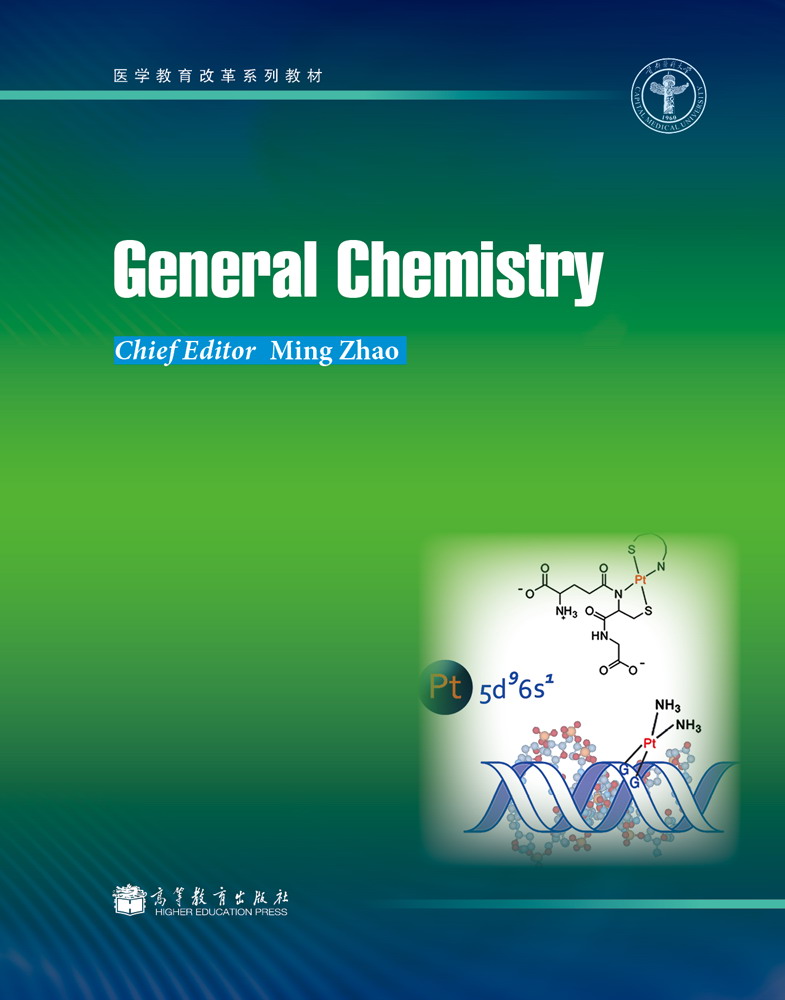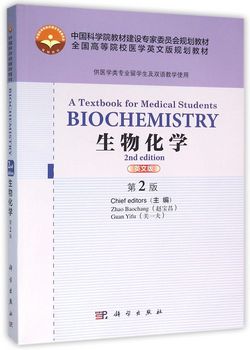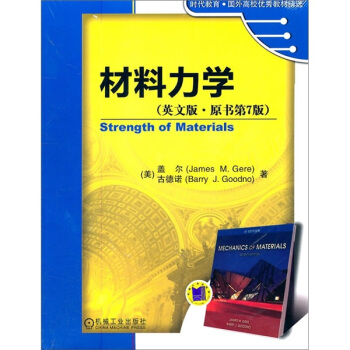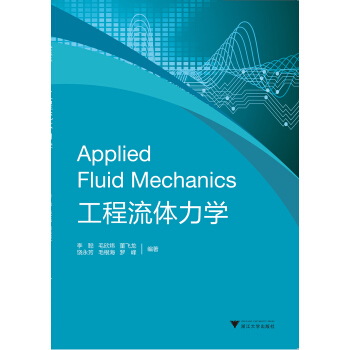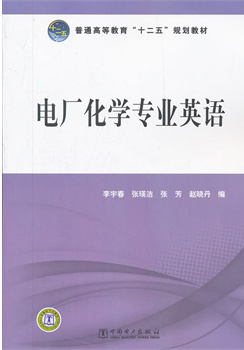General Chemistry
定价:¥37.00
作者: 赵明
出版时间:2012-11-14
出版社:高等教育出版社
- 高等教育出版社
- 9787040348125
- 1
- 35870
- 0045153028-1
- 平装
- 16开
- 2012-11-14
- 740
- 303
内容简介
《基础化学(英文版)》以英文的形式介绍了化学的基础知识,内容涉及溶液理论、酸碱平衡理论、重量分析法、滴定分析法、酸碱滴定法、非水滴定法、配位滴定法、沉淀滴定法、氧化还原滴定、比色分析及分光光度法、物质结构基础、烷烃与环烷烃、烯烃与炔烃、芳香烃与卤代烃、醇、酚、醚,醛和酮、羧酸及其衍生物、含氮有机化合物、杂环化合物。可应用于高职高专环境工程、化学分析、应用化工、煤化工等专业,也可应用于资源环境、生物工程、制药等专业以及在职职工的培训。
目录
Chapter 1 Introduction 1.1 History of Chemistry 1.2 Chemistry in Medicine 1.3 Measurement of Matter: the SI Unit 1.4 Quantitative Ways of Expressing Concentration 1.5 Chapter Summary Review Questions Answers ReferencesChapter 2 Colligative Properties of Dilute Solutions 2.1 Vapor Pressure Lowering 2.2 Boiling Point Elevation and Freezing Point Depression 2.3 Osmotic Pressure 2.4 Chapter Summary Review Questions Answers ReferencesChapter 3 Solution Electrolyte 3.1 Theory of Strong Electrolyte Solution 3.2 Proton Theory of Acids and Bases 3.3 Calculating the pH of Acid and Base Solution 3.4 Chapter Summary Review Questions Answers ReferencesChapter 4 Buffer Solution 4.1 Buffer Solution and How a Buffer Works 4.2 Calculating the pH of a Buffer Solution 4.3 Buffer Capacity and Buffer Range 4.4 Preparing Buffer Solutions 4.5 Buffer Solution in Human Blood 4.6 Chapter Summary Review Questions Answers ReferencesChapter 5 Equilibria of Sparingly Soluble Ionic Compounds 5.1 The Solubility Product Constant, Ksp 5.2 The Relationship between Solubility and Ksp 5.3 Predicting the Formation of a Precipitate: Q vs. Ksp 5.4 Equilibria Shift 5.5 Application of Ionic Equilibria to Medicine 5.6 Chapter Summary Review Questions Answers ReferencesChapter 6 Colloids and Emulsions 6.1 Introduction 6.2 Colloid 6.3 Sol 6.4 Polymer Solution 6.5 Chapter Summary Review Questions Answers ReferencesChapter 7 Chemical Thermodynamics 7.1 The First Law: The Concepts 7.2 The Extent of Chemical Reactions 7.3 Indirect Determination of AH: Hess's Law 7.4 Energy Values of Food 7.5 Chapter Summary Review Questions Answers ReferencesChapter 8 The Direction and of Chemical Reactions Equilibrium 8.1 Spontaneity: The Meaning of Spontaneous Change 8.2 Entropy and Entropy Change 8.3 Free Energy and Free Energy Change 8.4 Standard Free Energy Change, AGe 8.5 Relationship of AGe to AG for Nonstandard Conditions 8.6 Relationship ofAGe to the Equilibrium Constant Ke 8.7 Criteria for Spontaneous Change 8.8 Altering Equilibrium Conditions: Le Ch~terlier's Principle 8.9 The Le Chfitelier's Principle in Physiology 8.10 Chapter Summary Review Questions Answers ReferencesChapter 9 Kinetics: Rates and Mechanisms of Chemical Reactions 9.1 The Rates of Chemical Reactions 9.2 Rate Laws and Reaction Order 9.3 Rate Constant and Reaction Order 9.4 Reaction Mechanisms: Steps in the Overall Reaction 9.5 Theoretical Models for Chemical Kinetics 9.6 The Effect of Temperature on Reaction Rates 9.7 Catalysis 9.8 Chapter Summary Review QuestionsChapter 10 Electrochemistry 10.1 Oxidation-Reduction Reactions 10.2 Voltaic Cell 10.3 Electrode Potentials 10.4 Free Energy and Electrical Work 10.5 Predicting Spontaneous Reactions for Nonstandard Conditions 10.6 Chapter Summary Review Questions Answers ReferencesChapter 11 Atomic Structure and Periodical Table 11.1 The Discovery of Atomic Structure 11.2 Atomic Spectrum and the Bohr Model of the Atom 11.3 The Wave-Particle Duality of Matter and Energy 11.4 The Atomic Orbital and the Probable Location of the Electron 11.5 Quantum Numbers and Electron Orbitals 11.6 Electron Configurations 11.7 The Periodic Law and the Periodic Table 11.8 Chapter Summary Review Questions Answers ReferencesChapter 12 Covalent and Intermolecular Forces Bonding 12.1 The Covalent Bonding Model 12.2 Hybridization of Atomic Orbitals 12.3 Molecular Orbital (MO) Theory 12.4 Delocalized Electrons: Bonding in the Benzene Molecule 12.5 Intermolecular Forces 12.6 Chapter Summary Review Questions Answers ReferencesChapter 13 Chemistry Compounds of Coordination 13.1 The Structure of Complexes 13.2 Formulas and Names of Coordination Complexes 13.3 Isomerism 13.4 Chemical Bond Theories of Complexes 13.5 Aspects of Complex-Ion Equilibrium 13.6 Metals and Chelates in Living Systems 13.7 Chapter Summary Review QuestionsChapter 14 Acid-Base Titration 14.1 Getting Started: Some Terminology 14.2 Significant Figures 14.3 Acid-Base Indicator 14.4 Titration of a Strong Acid with a Strong Base 14.5 Titration of a Weak Acid with a Strong Base 14.6 Standardization of Acid (Base) Using a Primary Standard 14.7 Chapter Summary Review QuestionsChapter 15 Absorption Spectroscopy UV-Vis 15.1 UV-Vis Spectroscopic Regions 15.2 Beer-Lambert Law 15.3 UV/Vis Absorbance Bands and Structures Review Questions NotesIndexAppendix A--H

